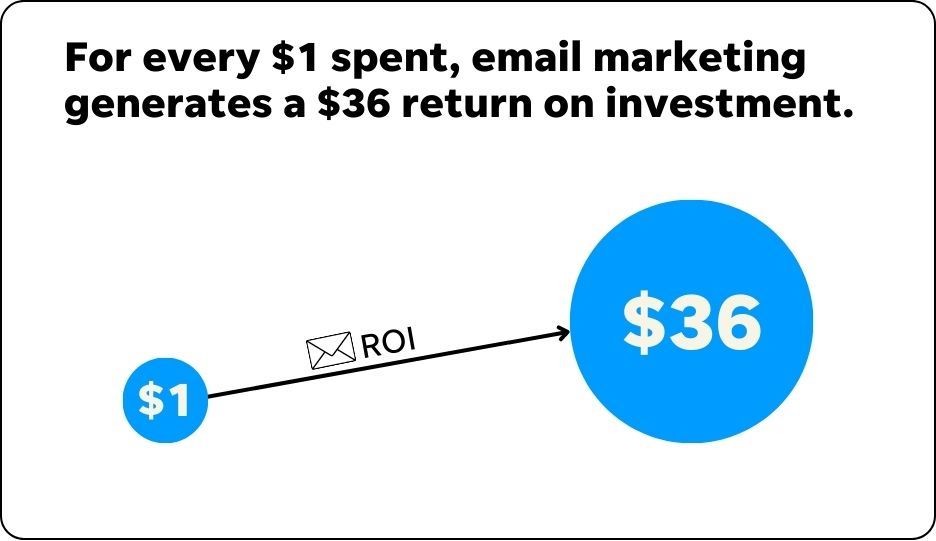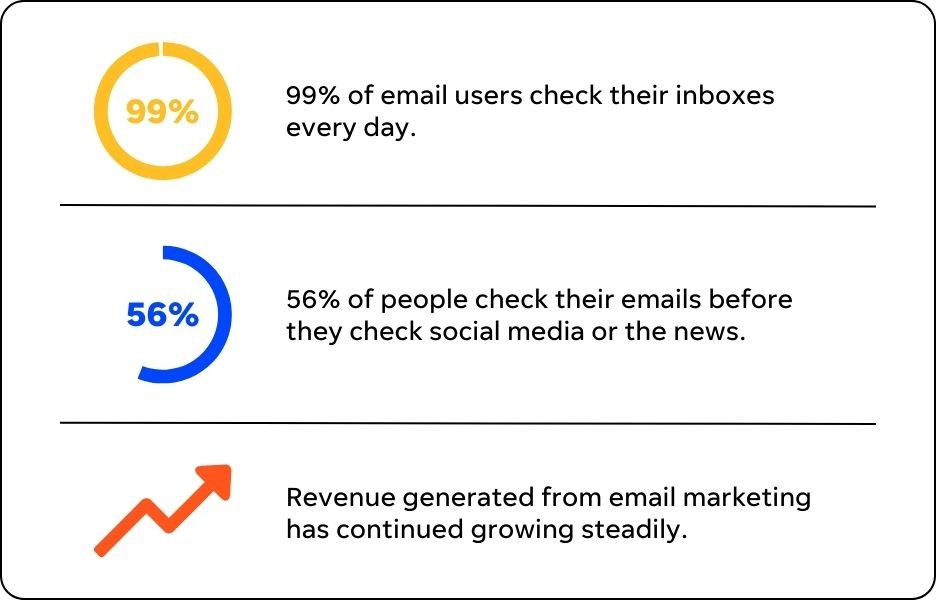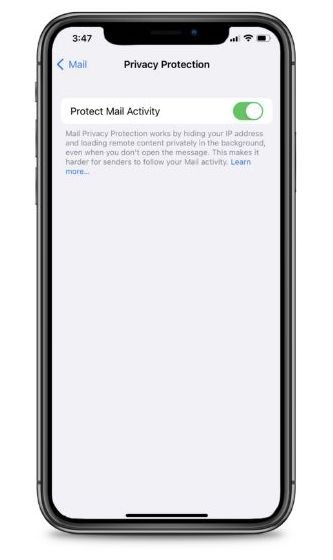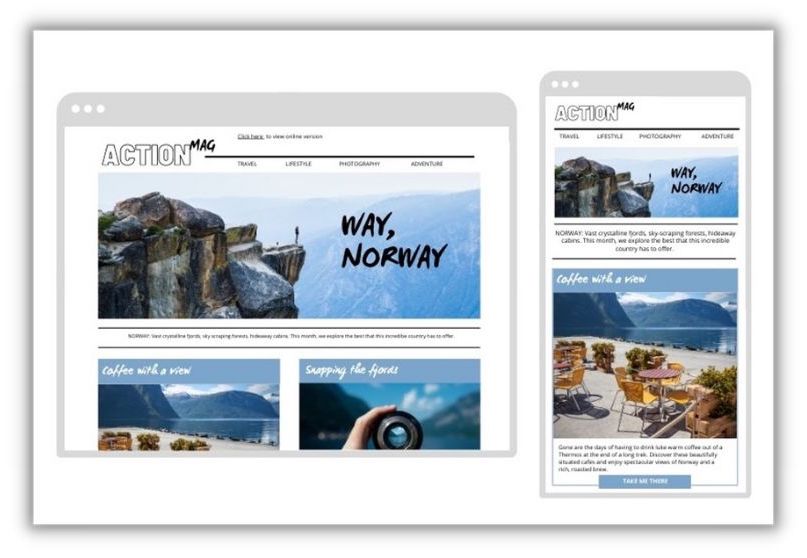Compared to having millions of followers and going viral on social media, email is understandably the less flashy of the marketing channels.
We get it–email isn’t sexy. It’s not the hot new thing. But you know what is sexy? A $36 return on every dollar spent. That’s what you (can) get with email marketing.
And in a time when so much is in flux with social media companies, dependability and reliability are huge pros to running email marketing.
Email marketing is not only a great way to get the word out about your business, but is also an effective tactic to keep your customers engaged, increase brand awareness, build trust, and drive sales.
In short–email marketing is worth investing in. And if you’re going to invest in it, you’re going to want to do it right. And to do it right, it helps to be up on both the latest trends and what’s proven to drive success.


Why email marketing?
Not convinced that email marketing is worth your time?
⬅️ Check out these statistics:
Email is here to stay. It’s effective, it’s personal, and people continue to use it. For all the reasons mentioned above, it’s still one of the most reliable platforms to market on, both now and in the future.
Email marketing trends that aren’t going away in 2023
Need some inspiration? These email marketing trends are now mainstream—and they’re not going away in 2023.
Welcome series emails
As you’re building your email list, you want a way to introduce new subscribers to your business, let them know what to expect from you, and provide additional information to nurture them through the funnel.
A welcome series of emails does just that.
At its core, the welcome series is an automated email sequence that gets triggered when a new subscriber signs up to join your email list.
One study showed that subscribers who read an initial welcome sequence will be 33% more likely to engage with a brand going forward.
Here are a few tips to make your welcome emails successful:
Ensure readers know what they can expect
Remember, this is your first impression with new subscribers. Let them know what type of communication to expect from you, when to expect it, and some examples of what they’ll see moving forward (like your best tips or posts).
Keep it simple
Your welcome emails don’t have to be long. In fact, it’s better if they’re short and sweet. Make sure each email in your welcome series has a clear call to action and orient your email around that.
Offer something valuable
Offering a welcome coupon or offer might go a long way in getting you your first sale from your new subscriber. Best to make the most of it! Even if you’re not offering a coupon, try to consider something “wow” worthy you can provide them as a way to stand out.
Ask for them to respond directly
Want to establish a relationship with your audience? It’s a good idea to let them know they can respond to you if they’d like, and that you’re the type of business owner who reads every response. Ask them what they’re looking for help with and send a custom response if you can. It’ll go a long way.
Newsletters
Newsletters are popular for a reason. When done right, they provide great value to your target audience and establish your business as both an authority and a reliable source of information–sometimes even as a trustworthy friend.
Many businesses use their newsletters as the foundation for their email marketing strategy. They do this to stay top of mind for prospective customers and to nurture relationships with existing ones.
Some things businesses include in their newsletters
- New blog announcements
- Summaries of their most popular content
- Company news and events
- Product announcements
- Feedback requests
- Occasional sales announcements (But use these sparingly or risk being seen as overly promotional and losing trust!)
The point? Bring value to your customers’ inboxes and they’ll be interested in continuing to read what you have to say. If they’re not yet ready to spend money with your business, your goal is to be the first brand they think of when they are.
Automated lead nurturing
A lead nurturing campaign is an automated email sequence designed to take prospects along a journey that marketers hope will impact their buying behavior.
These campaigns use email automation to send targeted emails to leads based on what you know about them, their past interactions with your business, and where they are in the sales funnel to guide them toward the action you ideally want them to take next.
For example, if a lead indicates they’re interested in getting help with selling their home, you can set your automation to send them a series of emails related to selling a home, including how to know it’s time to sell, tips for choosing the right realtor to list your home with, and testimonials from your existing clients who have sold a home with you.
Not sure how to segment in order to deliver what they need? Consider including a short survey in your welcome email for new subscribers to better understand what topics they’re interested in.
Remember: Your goal is to deliver a useful, valuable message to the right person at the right time.
Nurturing your sales leads in this format makes scaling infinitely simpler and allows you to fine-tune your automated marketing to convert more leads into customers.
Requests for feedback
Asking for customer feedback is an excellent way to learn what you are doing well and what you could improve upon.
Requesting feedback via email is an easy way to tap into what customers and prospects like about your business—and what they wish to improve.
Here are some tips for requesting feedback via email:
Explain why you’re requesting feedback in the first place
Before you ask for feedback, it’s important to tell customers why you’re asking. If you don’t tell them, they might wonder if you really care about their opinions or if this is just another way for you to get more sales.
Utilize a survey
After explaining your request for feedback to customers, you can choose from several ways to collect their responses. Surveys are one of the most common and effective methods.
Be respectful of your customer’s time by using a survey that will take less than five minutes to complete.
According to PointerPro, for surveys that are optimized correctly, you can expect to receive an average response rate of about 33%.
Implement feedback and follow up
Once you’ve collected your responses, make sure to implement what you can and follow up with your customers to let them know how you’ve used the information you collected. Note any improvements you’ve made to your business as a result and send a follow-up email so they know that you care about what they have to say.
Make email marketing trend higher in 2023
Email marketing is a constantly evolving challenge, but it’s also a constant opportunity to get ahead of your competitors.
The key to success is to always be on the lookout for new email marketing trends and best practices while listening to your customers and using the tools and insights at your disposal to get to continually improve your campaigns.
Keeping an eye on these email trends can help you develop an effective strategy for marketing your brand in both the short and long term.
Here are the top email marketing trends for 2023:
Privacy becomes a top priority
Perhaps this is less of a trend and more of a legal obligation, but a focus on data privacy and data protection is going to be absolutely critical in email marketing in 2023.
Famously dubbed “the age of digital privacy” thanks to laws like GDPR and CCPA, marketers are forced to oblige–and rightfully so–with user’s privacy requests.
While email marketing is certainly less intrusive than web tracking with cookies, data privacy laws still apply.
Running a safety-first email marketing campaign is relatively easy so long as you abide by the following three hard and fast rules:
- Utilize the double opt-in email list.
- Provide your readers with an easy way to opt out or unsubscribe from your emails and newsletters, labeled clearly within the body of your email.
- Don’t add users to your lists without their express permission.
Remember, letting users unsubscribe is not a bad thing. It reduces the number of people who are on your email list and not responding. For deliverability purposes, it’s infinitely better to have a decluttered email list of active subscribers than a large one that’s less active and engaged.

Open rate may become a KPI of the past
As a result of the aforementioned privacy-related laws and regulations, those running email marketing will have to continue adapting how they handle their users’ data while tracking and measuring their own performance.
Apple’s new privacy settings are an important step towards protecting customers’ personal information, but it’s thrown a major curveball at those who previously used the information collected to make informed decisions.
Email marketers can no longer track when or where users open their emails or what device they use to do so. In effect, they made open rate a significantly less dependable marketing metric.
The fallout from this, likely, will be that other metrics will become much more important, such as clicks and click-through rate (CTR), further strengthening the argument in favor of compelling calls-to-action and clickable links being provided more often than we’ve become accustomed to.

More focus on mobile-responsive design
This isn’t necessarily a new email marketing trend, but as 81% of people check their emails using a mobile device, it’s worth repeating. But it’s also worth mentioning that people DO still check their emails on desktop and tablet-sized screens.
This is why responsive email design is more important than ever.
Responsive design ensures emails are beautiful and effective regardless of the device they’re opened from.
Notice that because of the single-column layout, this email looks equally beautiful on a computer and phone screen.
Mobile-responsive emails are coded automatically by most email software. However, there are some tricks to mastering it:
- Limit your content to one column. Adding additional columns increases the likelihood that items will be misaligned on devices of differing sizes.
- Use a simple, clean font. Creative fonts can be difficult to read on smaller mobile devices.
- Use smaller images. When you’re creating an email for mobile devices, make sure your photos are sized appropriately.
It’s also important to test your emails across devices before sending them to make sure they render correctly, are easy to read, and you can click or tap on the calls to action.




